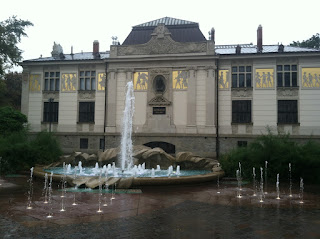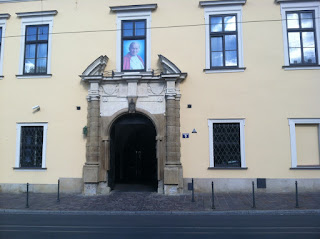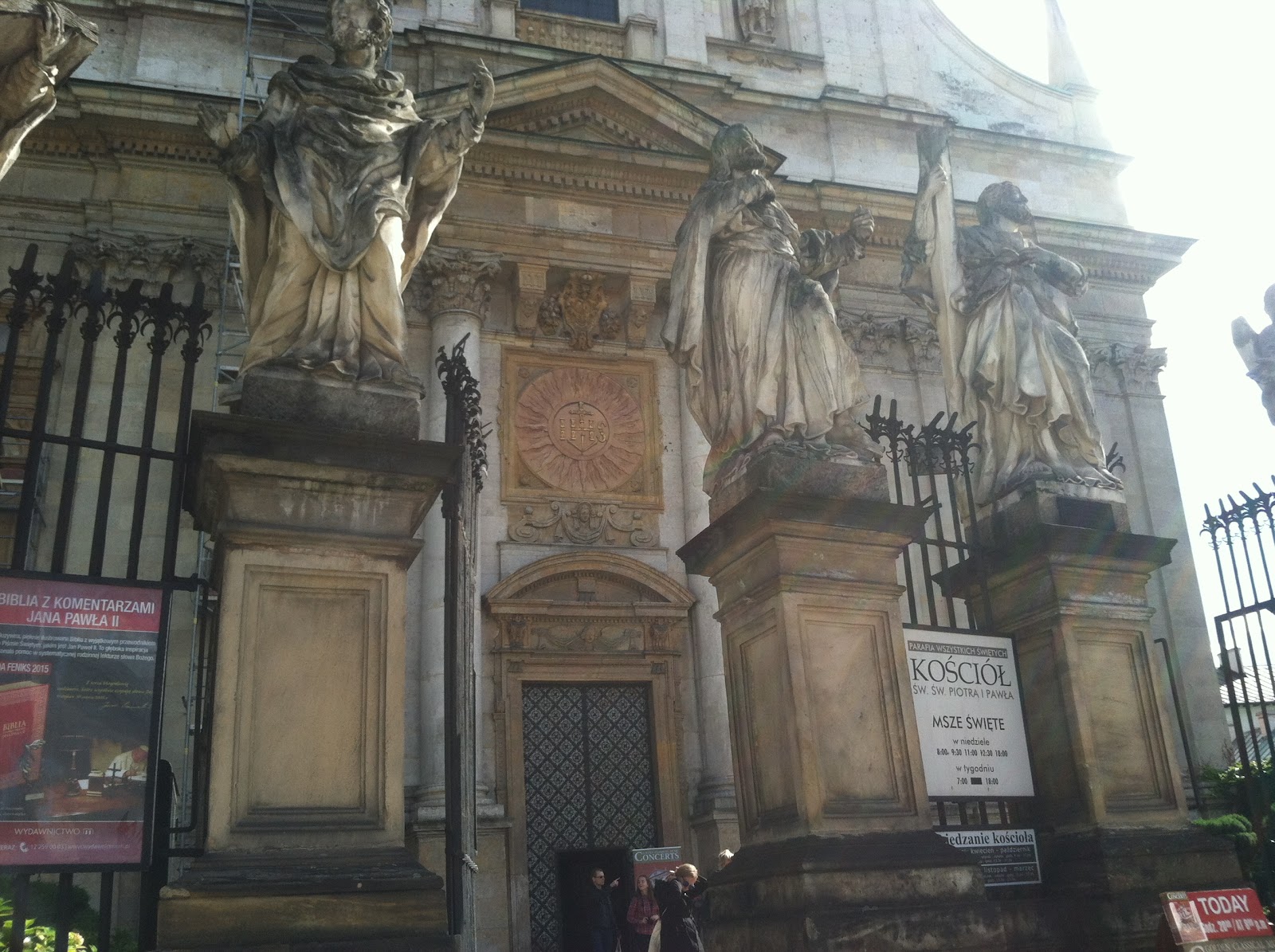Things were looking pretty glum this morning when both Kathy and I woke up before dawn. I struggled all night with a sore throat and woke up with a full-blown head cold. Kathy woke up with a bad headache. I took some DayQuil and Kathy took some aspirin and both of us went back to bed. When we woke back up around 9:00 AM, the sun was out and we got up, ready to go.
After a nice breakfast across the street, we decided to start by walking to Wawel Hill, where a castle has stood since the 10th century. We walked past the Solidarity office next to our guesthouse,
and across the plaza containing a branch of the National Gallery, featuring works by the Young Poland movement. Admission was free on Sunday, but we had so much to do, we didn't go in.
Since we had already seen the main market square, we walked right through to St. Francis' Church, which was the church that Karol Wojtyla (Pope John Paul II) used as the Archbishop of Krakow. We started to go in, but because it was noon, the Sunday Mass was in session. We actually didn't see the inside of any of the churches we went to because it was Sunday.
Across the street was the Archbishop's residence where the Wojtyla lived and stayed even after he became Pope (whenever he came back to Poland.) When he was in residence (it is said), he would come to the window over the entrance and talk to the people in the street about football and anything else on their minds. There is now just a picture of him in the window.
Further down Grodzka Street we came to the original market square of Krakow, now named Mary Magdalene Square, lined with yet more churches. Kathy liked this door-knocker on one of the buildings.
Krakow has more Catholic churches per square mile than any city in Europe, except for Rome. Here's a picture of Krakow's first Baroque church, the Church of Saints Peter and Paul, facing the square.
Once past the square we walked by several Cardinal's residences (you can tell because there is a Cardinal's hat carved into the stone over the doorway), and came to Wawel Hill at the very end of the old town. This is the most visited site in Poland, and today, with the wonderful weather, was no exception.
It's a long, huffing-and-puffing walk to the top of the hill. When you get there, it's surprising how big it is. I had wanted to go into Wawel Cathedral (the building on the left), but it also was closed for services. Past the Cathedral, we walked through the Renaissance passage ...
into the huge inner courtyard of the castle itself. Notice the three floors. The nobles at court lived on the bottom floor. The King lived on the middle floor, while the top floor, which is taller, was used for the public and ceremonial rooms.
The back wall is actually just that - a wall - with no building behind it. When visiting dignitaries from other countries would come visit, these windows would be draped, to give the impression that the King's palace was larger than it actually was.
According to European Theosophical tradition, the inner corner of this courtyard is one of the earth's seven Chakra points (along with New Delhi, Mecca, Delphi, Rome, Velehrad, Jerusalem). Tourists line up to touch the Chakra spot, while a disapproving guard prevents things from getting out of hand. The guards are actually prohibited from talking about it at all. You can see the hand-prints from everyone who touches the wall.
Of course this being the Internet age, I had to check my facts using Google. It looks like since the 1930s the seven points have moved again. One is now at Mt. Shasta.
The open area on the top of the hill is huge, so we had to walk all the way around it. On the south side you can look out over the Vistula. What a long river it is; here we are in the south and we saw it in Warsaw and also in Torun, in the north of Poland. All around the grounds, the chestnut trees are dropping their nuts, and families were out gathering them.
After our castle tour, we decided to head over to the old Jewish quarter called Kazmierz. This is not the Ghetto area during the war, but the pre-war Jewish quarter.
We stopped by the market square (Plac Nowy) and I had a zapiekanki, a toasted baguette with cheese and other toppings. Even though it was only around 3:00 pm, all of the market stalls were closing.
As long as we were outside the city walls, I asked Kathy if she was willing to walk over to the Oscar Schindler factory, made famous in Steven Speilberg's Shindler's List, which is now a museum. It took us about a half-hour to walk to the factory, along the way we saw the Ghetto Hero's square memorializing the Krakow Ghetto that was built here in the area called Podgorze. The empty chairs symbolize the fact that the Jews of Kazmierz had to carry everything, including their furniture, when they were expelled from Krakow.
The Schindler factory is a couple blocks away from the square, and houses a permanent exhibit called Krakow Under Nazi Occupation 1939-1945.
Like the History of the Jews in Poland exhibit in Warsaw, it is slick and well done, with both Polish and English explanations as you go along. Often, though, I found myself wondering what I was looking at, or how it fit into the overall story. I think a little additional narrative direction would have helped us a lot.
We watched a half-hour movie that was interesting, with actual survivors from the Schindler factory. That could have used some narrative work as well. If I hadn't seen the Spielberg movie, I really wouldn't have been able to follow what was going on. The highlight for me was standing behind Oscar Schindler's desk and seeing the pictures of those he had saved.
After the museum we had the long walk back to the Old Town to look forward to. The sun was just going down as we crossed the river.
We looked through our guidebooks and found a nice Polish-Italian fusion restaurant, and made a feast of four different starter plates: pierogi, golabki (stuffed cabbage rolls), potato pancakes with mushroom sauce, and some lasagna Bolonese.
It was more than enough food for us, so we felt no need to order a "main" plate.
Sunday, September 27, 2015
Subscribe to:
Post Comments (Atom)






















No comments:
Post a Comment
Unless you sign into a Google Account, you'll be anonymous. In that case, we'd love to know who you are. You can close your message with your name.